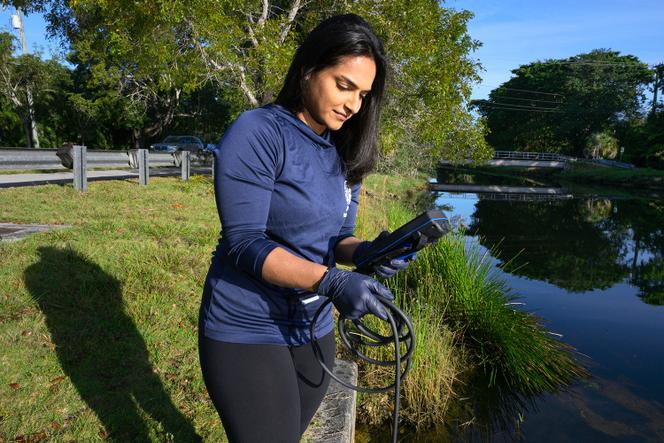


In Miami's upmarket Coral Gables district, a couple were walking their golden retrievers in the first rays of sunshine. They suddenly stopped in front of a young woman handling plastic bottles. On the banks of a canal that flows into Biscayne Bay, Aliza Karim dipped a probe into the brownish water.
Every week, the biologist from the Miami Waterkeeper organization analyzes samples in the lab. While the city authorities constantly monitor swimming waters, the association itself looks into sampling some 30 sites in parks and along the many canals that flow into Biscayne Bay. "We measure oxygen levels and water quality. We look for enterococci, which are indicators of fecal contamination."
During heavy rainfall, some neighborhoods overflow with nutrient-rich sludge (nitrogen, phosphates, etc.) and bacteria that are indicative of the presence of human or animal fecal matter. "The nutrients cause deoxygenation or green algae blooms, while the bacteria pose a public health problem for us," explained Roy Coley, head of the Miami-Dade County Wastewater Department. In short, Miami residents regularly have their golf shoes in their feces!
Rising water levels are a constant preoccupation in the area. The average height of the city is 1.2 meters above sea level. "We're standing on soil made up of porous, water-soaked limestone sedimentary rock," said Coley, "the subsoil is like Swiss cheese." Several times a year, high tides cause seawater to seep through the soil, resulting in astonishing flooding on a clear day.
In mid-November, heavy downpours coupled with these notorious tides plunged entire neighborhoods underwater. "Most of our samples in Miami and Fort Lauderdale showed abnormally high levels of bacteria. At several sites, the results exceeded 24,000 units per hundred milliliters of water! This is enormous, given that the rate recommended by public health experts is 70. We find fecal markers several dozen times a year, and it's very common after it rains," said Karim sadly. Even if Miami residents don't swim in the bay or the canals, knowing that the water is teeming with fecal matter is hardly appetizing.
But where does this "Miami poop" come from? "Septic tanks buried under the city's houses and businesses," said Coley. They fill up with wastewater, from showers and toilets and dish washing and release 'treated' water. But when the soil is soaked by rain or ocean water, the tanks overflow! This is what Caesar Suarez, a resident of Little River, one of the city's lowest-lying neighborhoods, has had to put up with for a long time. "Every time it rained a little, the sink was constantly clogged, and my wife washed the dishes in the garden. The toilet overflowed and I had to redo the entire floor. Basically, poop was floating in my yard." As a result, the owners were unable to enjoy their property.
You have 35% of this article left to read. The rest is for subscribers only.
